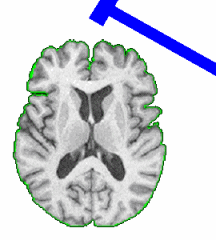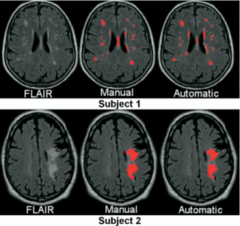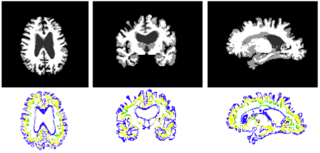Difference between revisions of "2009 UNC HAMMER WML"
| (One intermediate revision by the same user not shown) | |||
| Line 1: | Line 1: | ||
{| | {| | ||
|[[Image:NAMIC-SLC.jpg|thumb|320px|Return to [[2009_Winter_Project_Week|Project Week Main Page]] ]] | |[[Image:NAMIC-SLC.jpg|thumb|320px|Return to [[2009_Winter_Project_Week|Project Week Main Page]] ]] | ||
| − | |[[Image:HammerABrain.png|thumb| | + | |[[Image:HammerABrain.png|thumb|280px|Deformable registration using HAMMER ('''H'''eirarchical '''A'''ttribute '''M'''atching '''M'''echanism for '''E'''lastic '''R'''egistration)]] |
| − | |[[Image:WMLSegmentation.png|thumb| | + | |[[Image:WMLSegmentation.png|thumb|240px|White Matter Lesion Segmentation, comparison between manual and automated results]] |
|} | |} | ||
| Line 8: | Line 8: | ||
{| | {| | ||
| − | |[[Image:HammerAttribute.jpg|thumb| | + | |[[Image:HammerAttribute.jpg|thumb|240px|Components of Hammer Attribute Vectors]] |
|[[Image:HammerEdgeSelection.png|thumb|320px|Edge points selected at different deformation stage]] | |[[Image:HammerEdgeSelection.png|thumb|320px|Edge points selected at different deformation stage]] | ||
| − | |[[Image:HammerSimilarity.png|thumb| | + | |[[Image:HammerSimilarity.png|thumb|240px|Similarity map (middle column) computed on moving image (right) for the selected point on the fixed image (left, cross). Point indicated by a cross on the middle and right column is the point on the moving image that is the most similar to the picked point on the fixed image.]] |
|} | |} | ||
===Key Investigators=== | ===Key Investigators=== | ||
| Line 30: | Line 30: | ||
<div style="width: 40%; float: left;"> | <div style="width: 40%; float: left;"> | ||
<h1>Progress</h1> | <h1>Progress</h1> | ||
| − | Both HAMMER and WML segmentation algorithms have been distributed in binary forms for a number of years and have been used by some research groups. We will start with the algorithms in their current forms to generate ground truth on publically available data sets. A NITRC project is setup for collaboration between UNC and GE Research. | + | Both HAMMER and WML segmentation algorithms have been distributed in binary forms for a number of years and have been used by some research groups. We will start with the algorithms in their current forms to generate ground truth on publically available data sets. A NITRC project (http://www.nitrc.org/projects/hammerwml/) is setup for collaboration between UNC and GE Research. |
On Hammer side: | On Hammer side: | ||
Latest revision as of 15:50, 3 February 2009
Home < 2009 UNC HAMMER WML Return to Project Week Main Page |
Results from the new implementation are:
Key Investigators
- UNC: Dinggang Shen
- GE Research: Xiaodong Tao, Jim Miller
- UPenn: Christos Davatzikos (Consultant)
Objective
Design ITK classes for Hierarchical Attribute Matching Mechanism for Elastic Registration (HAMMER) and White Matter Lesion segmentation so that these algorithms can be easily implemented using the Insight Toolkit and integrated into Slicer. The goals of the week is to analyze the algorithms on the object level, map components to existing ITK classes, identify gaps, and start implementation. Will also identify testing dataset and generate baseline results for testing.
Approach, Plan
Software process embraced by NA-MIC community. We will be using NITRC as our CVS repository for development. We will develop the algorithms as well as the testing. The current binary distribution of the algorithms will serve as the baseline for our testing.Progress
Both HAMMER and WML segmentation algorithms have been distributed in binary forms for a number of years and have been used by some research groups. We will start with the algorithms in their current forms to generate ground truth on publically available data sets. A NITRC project (http://www.nitrc.org/projects/hammerwml/) is setup for collaboration between UNC and GE Research.
On Hammer side:
- HAMMER attribute vector computation has been implemented as an ITK Filter.
- Feature point selection has been implemented.
- Feature similarity computation has been implemented.
- Test data will be selected from OASIS database.
- HAMMER Registration is been implemented using ITK Finite Difference framework--itk::HammerDeformableRegistrationFunction and itk::HammerDeformableRegistrationFilter.
One WML Segmentation side:
- Skull stripping is being developed. For WML segmentation, skull stripping is not THE most critical piece. The accuracy requirement is relaxed.
- Support vector machine classification will be using/extending SVMShapeAnalysis in Namic Sandbox developed by MIT group.
- Test data is yet to be determined.
References
- Dinggang Shen, Christos Davatzikos, HAMMER: Hierarchical Attribute Matching Mechanism for Elastic Registration, IEEE Trans. on Medical Imaging, 21(11):1421-1439, Nov 2002.
- Zhiqiang Lao, Dinggang Shen, Dengfeng Liu, Abbas F Jawad, Elias R Melhem, Lenore J Launer, Nick R Bryan, Christos Davatzikos, Computer-Assisted Segmentation of White Matter Lesions in 3D MR images, Using Pattern Recognition, Academic Radiology, 15(3):300-313, March 2008.




